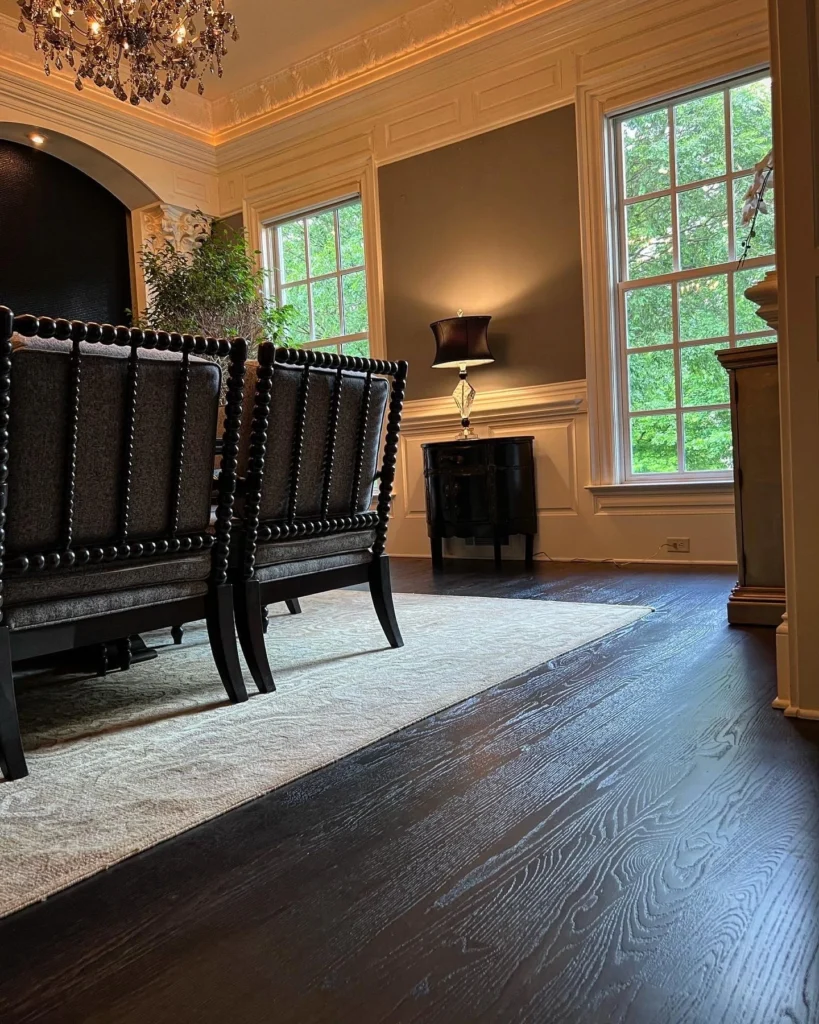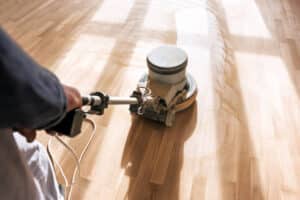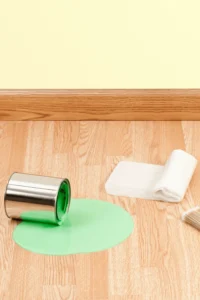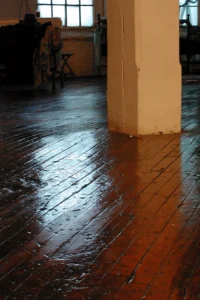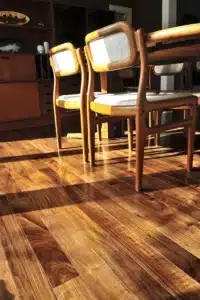Have you ever found yourself slipping and sliding on your hardwood floors, despite them looking clean and shiny?
It’s a common issue that many homeowners face, and it can be both annoying and hazardous! Understanding the reasons behind slippery hardwood floors is the first step in preventing those unexpected skids and ensuring your home remains safe and comfortable.
One of the most common reasons for slippery floors is improper cleaning methods. Many people use oil-based cleaners or too much polish, which can leave a residue that reduces traction and increases slipperiness. It’s crucial to use the right cleaning products specifically designed for hardwood floors and follow the manufacturer’s instructions to avoid creating a slick surface.
Environmental factors also play a significant role in the slipperiness of your floors. High humidity levels can cause the wood to swell and create a smoother surface, making it easier to slip. Conversely, dry air can lead to gaps and cracks in the floor, which can also contribute to a lack of grip. Maintaining a consistent indoor humidity level between 35% and 55% can help prevent these issues.
Lastly, wear and tear over time can naturally lead to a smoother surface on your hardwood floors. High-traffic areas are particularly prone to becoming more polished and, consequently, more slippery. Regular maintenance, such as sanding and refinishing, can help restore the texture and reduce slipperiness.
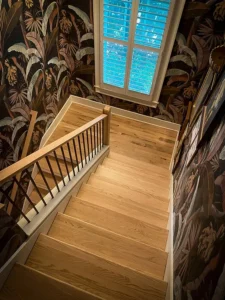
What Makes Hardwood Floors Slippery?
Slippery hardwood floors can be a nuisance, and understanding the various factors that contribute to this issue is key to finding effective solutions.
Let’s dive deeper into how to make hardwood floors less slippery!
Residue from Cleaning Products
The residue from cleaning products is a major contributor to slippery hardwood floors. When using the wrong products or methods, a film can form on the surface, reducing traction and increasing the risk of slips.
It’s crucial to use cleaners specifically designed for hardwood floors, as they are formulated to clean effectively without leaving a slippery residue. Proper cleaning techniques, such as using a damp (not wet) mop and avoiding excessive water, can help prevent slipperiness.
Additionally, always adhere to the manufacturer’s recommendations and use approved cleaning solutions to maintain the integrity and safety of your floors.
Moisture and Humidity
If the seasons have changed and you’re suddenly wondering “Why are my hardwood floors suddenly slippery?” it might be because of the weather or climate you’re in!
Moisture and humidity are significant factors in making hardwood floors slippery. Spills should be cleaned up immediately to prevent the liquid from penetrating the wood and creating a slick surface. High humidity levels can also cause the wood to absorb moisture from the air, leading to swelling and a smoother, more slippery surface.
To combat this, maintain indoor humidity levels between 35% and 55% using dehumidifiers or air conditioners. Regularly checking for signs of moisture and addressing any issues promptly can help keep your hardwood floors safe and slip-free.
Wear and Tear
The wear and tear from regular foot traffic can also make your hardwood floor too slippery. Over time, the finish can wear down, especially in high-traffic areas like hallways and entryways, resulting in a smoother surface that lacks the necessary traction.
To mitigate this, consider using area rugs or runners in these zones to reduce direct contact with the floor. Regular maintenance, like reapplying finish or polishing, can also help restore the floor’s texture and reduce slipperiness.
Inadequate Floor Finishes
The type of finish on your hardwood floors can greatly influence their slipperiness.
High-gloss finishes, while aesthetically pleasing, tend to be more slippery than matte or satin finishes. When choosing a finish, consider your lifestyle and the level of foot traffic in your home. Matte and satin finishes offer better traction and may be more suitable for busy households.
Wax coatings can also build up over time, creating a slippery surface. You’ll need to have a regular wax removal protocol to maintain traction on the floor.
To properly apply and remove wax without increasing slipperiness, use a thin layer of wax and buff it thoroughly.
When it’s time to remove the wax, use a wax stripper specifically designed for hardwood floors, and follow up with a thorough cleaning to ensure all residue is removed.
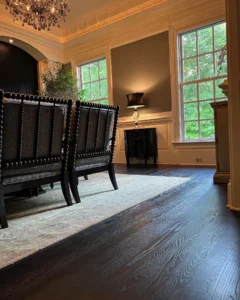
Improper Installation or Maintenance
Of course, we all want to assume the best and that our hardwood floors are installed properly.
But sometimes, installation crews mess up and leave uneven areas, gaps, or warping, which can significantly increase the risk of slipperiness. Any of these issues can create an inconsistent surface that lacks the necessary traction, making it easier to slip and fall.
To prevent these problems, it’s essential to have your hardwood floors installed by experienced hardwood flooring professionals who can ensure that the installation is done correctly and to the highest standards.
Regular maintenance is also key to keeping your floors in top condition. This includes periodic inspections to identify any potential issues before they become serious problems. Professional maintenance services can address these issues promptly, ensuring that your floors remain safe and slip-resistant.
How to Get Rid of Slippery Hardwood Floors
Slippery hardwood floors can pose a safety risk, but there are several effective solutions and preventive measures you can take to address and prevent this issue. Let’s explore some of the options available:
Rugs or Mats
Placing rugs or mats in high-traffic areas is a simple and effective way to provide traction and reduce slipperiness. This can be particularly useful in entryways, hallways, and near sinks or stoves, where the risk of slipping is higher.
When choosing rugs or mats, it’s important to select options that are specifically designed for hardwood floors. Look for rugs with non-slip backing or use rug pads underneath to prevent the rug from sliding and to protect the floor from any potential damage.
Anti-Slip Paint
For a more permanent solution, anti-slip paint can be applied to hardwood floors to increase traction. This specialized paint contains additives that create a textured surface, making it less slippery.
There are different types of anti-slip paints available, like water-based and solvent-based options. When choosing an anti-slip paint, consider the level of foot traffic in the area and the desired finish. It’s also important to follow the manufacturer’s instructions carefully to ensure proper application and effectiveness.
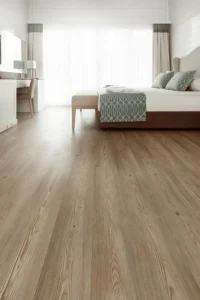
Choose an Oil Finish
Switching from a wax coating to an oil finish can significantly reduce the slipperiness of your hardwood floors. Oil finishes penetrate deeper into the wood, providing a more natural, matte finish that offers better traction compared to the slick surface created by wax.
When applying an oil finish, ensure the floor is clean and dry, then apply the oil evenly according to the manufacturer’s instructions. Regular maintenance is essential to keep the oil finish in top condition, which may include periodic reapplication and gentle cleaning with suitable products.
Getting Your Floor Sanded
Sanding your hardwood floors can effectively increase traction by roughening the surface, making it less slippery. This process involves removing the top layer of the finish, revealing a fresh, textured surface underneath. If you’re considering getting your floor sanded, it’s advisable to hire professional sanding services to ensure the job is done correctly and safely.
Before the sanding process begins, prepare your home by removing furniture, covering vents and doorways with plastic sheeting to contain dust, and ensuring good ventilation.
Partner with the TriArt Team for Perfect Hardwood Floors!
If you’re looking for expert assistance to address slippery hardwood floors (or to prevent them from ever happening!), partner with our qualified team of hardwood floor specialists at TriArt!
With top-notch hardwood floor services including professional sanding, finishing, and maintenance, we’ll help you achieve safe and beautiful hardwood floors and prevent them from slipping. Fill out our online form or give us a call to get started!

